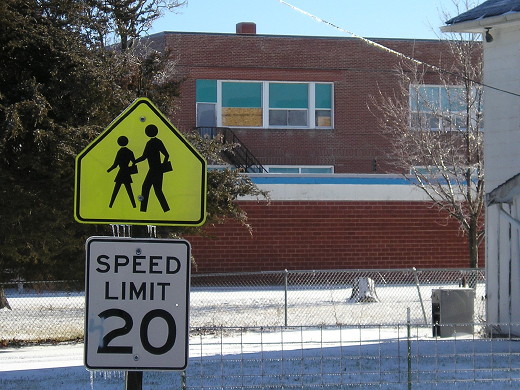
December 28, 2008: Every window in the Russell school building was boarded up shortly after the district was forcibly dissolved. Students in Russell now go to Chariton, which encompasses about 85% of Lucas County.
Lucas County was the home of John L. Lewis, longtime leader of the United Mine Workers of America. It’s perhaps fitting, then, that the Lucas County town of Russell would become the canary in the consolidation coal mine.
On March 11, 2008, the State Board of Education de-accredited the Russell School District because the district had exceeded its spending authority in multiple years and had issues with teacher certification. (A state audit later found $300,000 of local sales tax revenue had been siphoned off to pay salaries, which is expressly forbidden under Iowa Code.) Russell became the second school district in Iowa history to be forcibly dissolved, following Hedrick in 1991. Because 94.5% of the district was in Lucas County, the state simply gave all of that to Chariton (an additional 5% went to Wayne, 0.5% to Albia). In fall 2008, Chariton High School became the ninth in Iowa to cover an area larger than 350 square miles.
In 2009, the wave rolled through northwest Iowa and hasn’t abated since. Battle Creek-Ida Grove and Odebolt-Arthur engaged in whole-grade sharing, a consolidation that has yet to be finalized. Ten. Pocahontas Area and Pomeroy-Palmer did the same. Eleven. When consolidation followed three years later, Pocahontas Area — just barely — became the fifth district in the state to exceed 400 square miles.
In 2010, the last class graduated from Lineville-Clio High School and the Wayne district in Corydon gained that area. When that happened, that little bit of Russell ended up nudging Wayne past the 350 mark, too. Twelve. Also in 2010, South Clay dissolved. It was down to a K-6 district but other students went to multiple surrounding districts. Part of South Clay went to Sioux Central. Since Albert City-Truesdale had been sending grades 7-12 there since 2004, the high school in Sioux Rapids was now covering 372 square miles. Thirteen.
A year later, Titonka and Woden-Crystal Lake went their separate ways, and Titonka’s 91 square miles were attached to Algona’s 283. Fourteen.
Also in the Kossuth County area, where the population decline is especially steep, three districts negotiated the most ambitious whole-grade sharing plan since the formation of North Iowa in 1989. North Kossuth and Sentral of Fenton began whole-grade sharing in 2008 as North Sentral Kossuth, and then in 2012 Armstrong-Ringsted was folded in. Fifteen.
Their resulting three-way sharing agreement, called North Union High School, is a geographic giant, one-seventh larger than the Davis County district, covering 540 square miles. It runs 32 miles along the Minnesota border and extends down to US 18 just north of Whittemore. It brings together seven towns, none of which has a population above 1000.
There were two other large-area whole-grade sharing agreements in 2012: Southern Cal and Rockwell City-Lytton (South Central Calhoun), and East Greene and Jefferson-Scranton (Greene County). Five years earlier, they would have been notable for their size, but were now just thrown on the pile.
In those five years (2008-09 to 2012-13), any informal idea of just how big a school district should be changed. Forget 350 square miles. Rural areas were now looking at 400 — and beyond.
Area figures are based on numbers received from the Iowa Department of Management.
